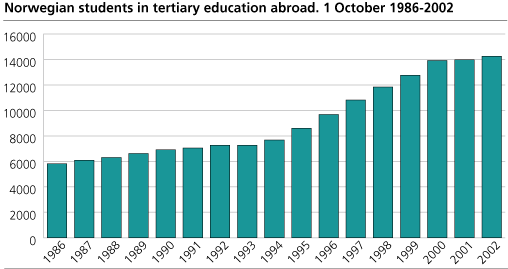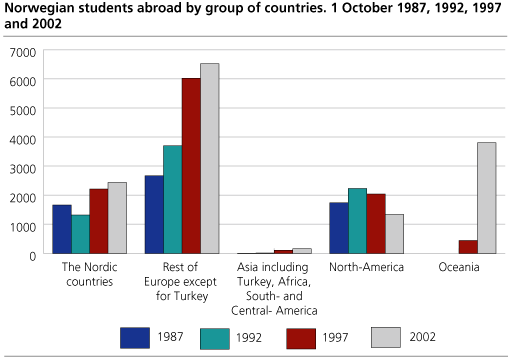Norwegian students abroad
Majority of female students abroad
Published:
In 2002 more than 14 200 Norwegian students, with support from the Norwegian State Educational Loan Fund, attended tertiary education abroad. The development represented an increase of almost 7 000 students over a ten-year period. More than 55 per cent of the students abroad were women.
6.3 per cent of all Norwegian students studied abroad in 2002. The corresponding figure for 1986 was 5.5 per cent. The portion of Norwegian students abroad was at peak in 2000, when 7 per cent of the students were enrolled in tertiary education outside Norway. The portion of female students abroad has increased nearly every year. In 1986 only one out of three students abroad were female. Since 1995 there has been a female majority among students abroad. The majority of students abroad were in the age group 20 to 24 years.
Australia is popular
It has traditionally been most common for Norwegian students to study in countries in Europe, USA or Canada. Until 1993 the Loan Fund normally only gave support to studies in these countries. From the academic year 1993/94, however, the Loan Fund granted loans and scholarships to all destinations. Accordingly, Australia has become a popular destination for a lot of the Norwegian students. In 2002 more than 3 800 Norwegian students studied in the Oceania, the majority in Australia and New Zealand. Only a few Norwegian students studied in Asia, Africa or South- or Central-America, a total of 150 students in 2002. Over the past few years the USA has become a less popular destination. In 1992 about 2 100 Norwegian students were enrolled in the USA. Ten years later the figure was almost cut in half. Denmark is the most popular country of destination among the Nordic countries. Almost 1 700 of the students abroad preferred studies in Denmark, whereas 700 preferred Sweden. Denmark has become more popular the last few years, while fewer students choose to study in Sweden. The UK is the most popular destination in Europe, as more than 3 200 Norwegian students were enrolled in the UK in 2002.
Norwegian students prefer studies in business and administration
More than 60 per cent of the Norwegian students abroad participated in a short tertiary education. Short tertiary education lasts four years or less. The majority of these students attended courses in business and administration. A long tertiary education lasts more than four years, and most of these students attended courses in health, welfare and sport. The largest portions of females in short tertiary education is found in primary industries, whereas the largest portion of women in long tertiary education is found in pedagogy. The male students chose technical subjects at both levels of tertiary education.
Parents' level of education makes a difference
Norwegian students are more likely to study abroad if their parents have attained a high level of education. About 6 per cent of the students in Norway in 2002 had parents with primary or lower secondary education as the highest attained level of education, while 2 per cent of the students attending courses abroad had parents where education attainment level at the equivalent level. Just above 13 per cent of the students in Norway had parents who have attained a long tertiary education, while the corresponding figure for the Norwegian students abroad was about 25 per cent. One out of three students in Norway had parents who have attained upper secondary education, and one out of three had parents who have attained short tertiary education.
Tables
- Table 1 Students in tertiary education in Norway and Norwegian students abroad. 1 October 1986-2002
- Table 2 Norwegian students in tertiary education abroad. Portion of female students. 1 October 1986-2002
- Table 3 Norwegian students in tertiary education abroad, by age group. Portion of female students. 1 October 2002
- Table 4 Students in tertiary education in Norway and Norwegian students abroad, by county of residence at 16 years of age. 1 October 2002
- Table 5 Norwegian students in tertiary education abroad, by groups of countries. 1 October 1986-2002
- Table 6 Norwegian students in tertiary education abroad, by countries. Portion of females. 1 October 1992, 1997 and 2002
- Table 7 Norwegian students abroad, by level and field of study. 1 October 1992, 1997 and 2002. Per cent
- Table 8 Norwegian students abroad, by gender, level and field of study. Per cent. 1 October 2002
- Table 9 Students in tertiary education in Norway and Norwegian students abroad, by parents' level of education 1 October 1992 and 2002
Contact
-
Statistics Norway's Information Centre


